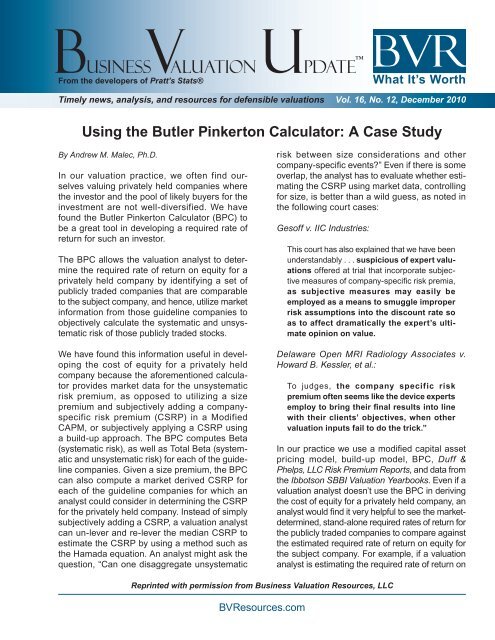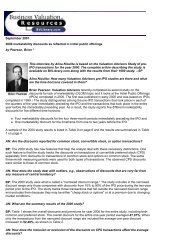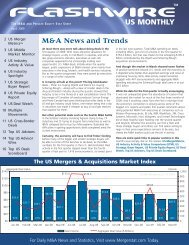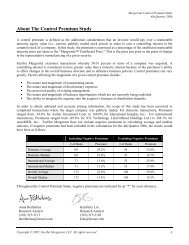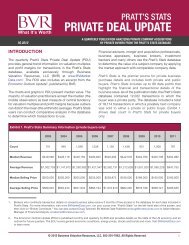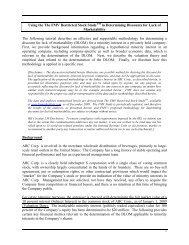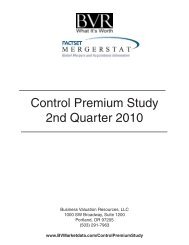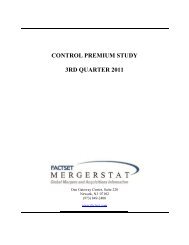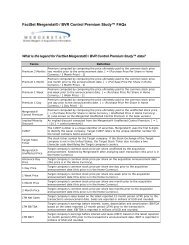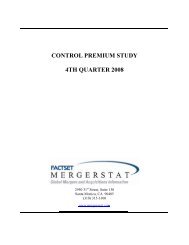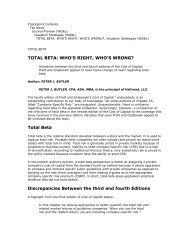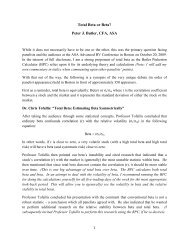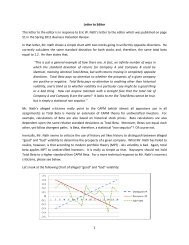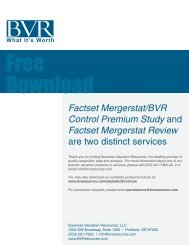A Case Study - BVMarketData
A Case Study - BVMarketData
A Case Study - BVMarketData
Create successful ePaper yourself
Turn your PDF publications into a flip-book with our unique Google optimized e-Paper software.
Business Valuation Update <br />
From the developers of Pratt’s Stats®<br />
Timely news, analysis, and resources for defensible valuations<br />
Vol. 16, No. 12, December 2010<br />
Using the Butler Pinkerton Calculator: A <strong>Case</strong> <strong>Study</strong><br />
By Andrew M. Malec, Ph.D.<br />
In our valuation practice, we often find ourselves<br />
valuing privately held companies where<br />
the investor and the pool of likely buyers for the<br />
investment are not well-diversified. We have<br />
found the Butler Pinkerton Calculator (BPC) to<br />
be a great tool in developing a required rate of<br />
return for such an investor.<br />
The BPC allows the valuation analyst to determine<br />
the required rate of return on equity for a<br />
privately held company by identifying a set of<br />
publicly traded companies that are comparable<br />
to the subject company, and hence, utilize market<br />
information from those guideline companies to<br />
objectively calculate the systematic and unsystematic<br />
risk of those publicly traded stocks.<br />
We have found this information useful in developing<br />
the cost of equity for a privately held<br />
company because the aforementioned calculator<br />
provides market data for the unsystematic<br />
risk premium, as opposed to utilizing a size<br />
premium and subjectively adding a companyspecific<br />
risk premium (CSRP) in a Modified<br />
CAPM, or subjectively applying a CSRP using<br />
a build-up approach. The BPC computes Beta<br />
(systematic risk), as well as Total Beta (systematic<br />
and unsystematic risk) for each of the guideline<br />
companies. Given a size premium, the BPC<br />
can also compute a market derived CSRP for<br />
each of the guideline companies for which an<br />
analyst could consider in determining the CSRP<br />
for the privately held company. Instead of simply<br />
subjectively adding a CSRP, a valuation analyst<br />
can un-lever and re-lever the median CSRP to<br />
estimate the CSRP by using a method such as<br />
the Hamada equation. An analyst might ask the<br />
question, “Can one disaggregate unsystematic<br />
risk between size considerations and other<br />
company-specific events” Even if there is some<br />
overlap, the analyst has to evaluate whether estimating<br />
the CSRP using market data, controlling<br />
for size, is better than a wild guess, as noted in<br />
the following court cases:<br />
Gesoff v. IIC Industries:<br />
This court has also explained that we have been<br />
understandably . . . suspicious of expert valuations<br />
offered at trial that incorporate subjective<br />
measures of company-specific risk premia,<br />
as subjective measures may easily be<br />
employed as a means to smuggle improper<br />
risk assumptions into the discount rate so<br />
as to affect dramatically the expert’s ultimate<br />
opinion on value.<br />
Delaware Open MRI Radiology Associates v.<br />
Howard B. Kessler, et al.:<br />
To judges, the company specific risk<br />
premium often seems like the device experts<br />
employ to bring their final results into line<br />
with their clients’ objectives, when other<br />
valuation inputs fail to do the trick.”<br />
In our practice we use a modified capital asset<br />
pricing model, build-up model, BPC, Duff &<br />
Phelps, LLC Risk Premium Reports, and data from<br />
the Ibbotson SBBI Valuation Yearbooks. Even if a<br />
valuation analyst doesn’t use the BPC in deriving<br />
the cost of equity for a privately held company, an<br />
analyst would find it very helpful to see the marketdetermined,<br />
stand-alone required rates of return for<br />
the publicly traded companies to compare against<br />
the estimated required rate of return on equity for<br />
the subject company. For example, if a valuation<br />
analyst is estimating the required rate of return on<br />
Reprinted with permission from Business Valuation Resources, LLC<br />
BVResources.com
Using the Butler Pinkerton Calculator: A <strong>Case</strong> <strong>Study</strong><br />
Business Valuation Update<br />
Executive Editor:<br />
Jan Davis<br />
Legal Editor:<br />
Sherrye Henry Jr.<br />
CEO, Publisher:<br />
David Foster<br />
Managing Editor:<br />
Janice Prescott<br />
Contributing Editors:<br />
Adam Manson,<br />
Vanessa Pancic, Doug Twitchell<br />
Graphic & Technical Designer: Paul Erdman<br />
Customer Service:<br />
Stephanie Crader<br />
Sales and Site Licenses: Linda Mendenhall<br />
President:<br />
Lucretia Lyons<br />
Editorial Advisory Board<br />
NEIL J. BEATON<br />
CPA/ABV, CFA, ASA<br />
GRANT THORNTON<br />
SEATTLE, WASH.<br />
JOHN A. BOGDANSKI, ESQ.<br />
LEWIS & CLARK<br />
LAW SCHOOL<br />
PORTLAND, ORE.<br />
NANCY J. FANNON<br />
ASA, CPA/ABV, MCBA<br />
FANNON VALUATION GROUP<br />
PORTLAND, ME.<br />
JAY E. FISHMAN<br />
FASA, CBA<br />
FINANCIAL RESEARCH<br />
ASSOCIATES<br />
BALA CYNWYD, PA.<br />
LYNNE Z. GOLD-BIKIN, ESQ.<br />
WOLF, BLOCK, SCHORR<br />
& SOLIS-COHEN<br />
NORRISTOWN, PA.<br />
LANCE S. HALL, ASA<br />
FMV OPINIONS<br />
IRVINE, CALIF.<br />
JAMES R. HITCHNER<br />
CPA/ABV, ASA<br />
THE FINANCIAL<br />
VALUATION GROUP<br />
ATLANTA, GA.<br />
JARED KAPLAN, ESQ.<br />
MCDERMOTT, WILL & EMERY<br />
CHICAGO, ILL.<br />
JAMES S. RIGBY, ASA, CPA/ABV<br />
IN MEMORIAM (1946 – 2009)<br />
GILBERT E. MATTHEWS CFA<br />
SUTTER SECURITIES<br />
INCORPORATED<br />
SAN FRANCISCO, CALIF.<br />
Z. CHRISTOPHER MERCER<br />
ASA, CFA<br />
MERCER CAPITAL<br />
MEMPHIS, TENN.<br />
JOHN W. PORTER<br />
BAKER & BOTTS<br />
HOUSTON, TX.<br />
RONALD L. SEIGNEUR<br />
MBA CPA/ABV CVA<br />
SEIGNEUR GUSTAFSON<br />
LAKEWOOD, COLO.<br />
BRUCE SILVERSTEIN, ESQ.<br />
YOUNG, CONAWAY, STARGATT<br />
& TAYLOR<br />
WILMINGTON, DEL.<br />
JEFFREY S. TARBELL<br />
ASA, CFA<br />
HOULIHAN LOKEY<br />
SAN FRANCISCO, CALIF.<br />
GARY R. TRUGMAN<br />
ASA, CPA/ABV, MCBA, MVS<br />
TRUGMAN VALUATION<br />
ASSOCIATES<br />
PLANTATION, FLA.<br />
KEVIN R. YEANOPLOS<br />
CPA/ABV/CFF, ASA<br />
BRUEGGEMAN & JOHNSON<br />
YEANOPLOS, P.C.<br />
TUCSON, ARIZ.<br />
Business Valuation Update (ISSN 1088-4882) is published monthly by Business<br />
Valuation Resources, LLC, 1000 SW Broadway, Suite 1200, Portland, OR, 97205-<br />
3035. Periodicals Postage Paid at Portland, OR, and at additional mailing offices.<br />
Postmaster: Send address changes to Business Valuation Update, Business<br />
Valuation Resources, LLC, 1000 SW Broadway, Suite 1200, Portland, OR, 97205-3035.<br />
The annual subscription price for the Business Valuation Update is $359. Low<br />
cost site licenses are available for those wishing to distribute the BVU to their colleagues<br />
at the same address. Contact our sales department for details. Please feel<br />
free to contact us via email at customerservice@BVResources.com, via phone at<br />
503-291-7963, via fax at 503-291-7955 or visit our web site at BVResources.com.<br />
Editorial and subscription requests may be made via email, mail, fax or phone.<br />
Please note that by submitting material to BVU, you are granting permission for the<br />
newsletter to republish your material in electronic form.<br />
Although the information in this newsletter has been obtained from sources that<br />
BVR believes to be reliable, we do not guarantee its accuracy, and such information<br />
may be condensed or incomplete. This newsletter is intended for information purposes<br />
only, and it is not intended as financial, investment, legal, or consulting advice.<br />
Copyright 2010, Business Valuation Resources, LLC (BVR). All rights reserved. No<br />
part of this newsletter may be reproduced without express written consent from BVR.<br />
equity for a privately held company for an undiversified<br />
investor at 15% and the BPC is showing<br />
that the total cost of equity is 23% for an undiversified<br />
investor, then the analyst needs to ask if the<br />
investment in the subject company should be less<br />
riskier than that of a publicly traded stock. It may<br />
mean that the analyst is not properly capturing the<br />
required rate of return on equity. We have found<br />
the ability to benchmark the stand-alone, required<br />
rates of return of the publicly traded companies,<br />
and the resulting Total Beta calculation, a valuable<br />
tool in our practice and in supporting our cost of<br />
equity estimates.<br />
For example, we recently valued a company in<br />
the automotive industry where we utilized a buildup<br />
method and a modified capital asset pricing<br />
model to estimate the cost of equity and utilized<br />
the market-derived CSRP from the BPC for our<br />
estimate of the subject company’s CSRP. Since<br />
our CSRP estimate was based on the guideline<br />
companies and objectively determined, as<br />
opposed to subjectively derived, we felt that our<br />
CSRP estimate was reasonable. We also wanted<br />
to ensure that we could address any overlay in<br />
the size premium and the CSRP, so we also utilized<br />
Total Beta to estimate the cost of equity,<br />
calculating similar results. Finally, the median and<br />
average total cost of equity from the guideline<br />
companies was consistent with our required rate<br />
of return estimate, suggesting our cost of equity<br />
estimate was reasonable and provided a “gut<br />
check” on our analysis and a test of reasonableness<br />
to parties involved in the matter.<br />
The BPC does not purport to be the “end all”<br />
in calculating the cost of equity, but presents<br />
another economic model for the analyst to consider<br />
in estimating such cost. In our opinion, the<br />
BPC is a tool that all valuation analysts should<br />
have in their toolbox.<br />
Andrew M. Malec, Ph.D., is managing director of<br />
valuation, litigation advisory & forensic services<br />
at Gordon Advisors PC inTroy, Mich.<br />
Reprinted with permissions from<br />
Business Valuation Resources, LLC<br />
2 Business Valuation Update December 2010


